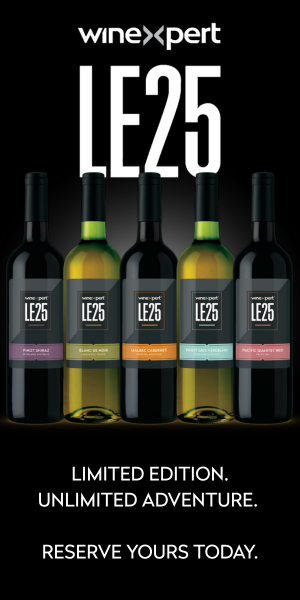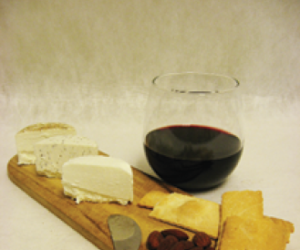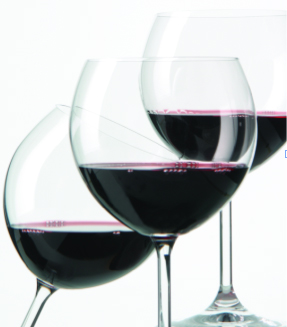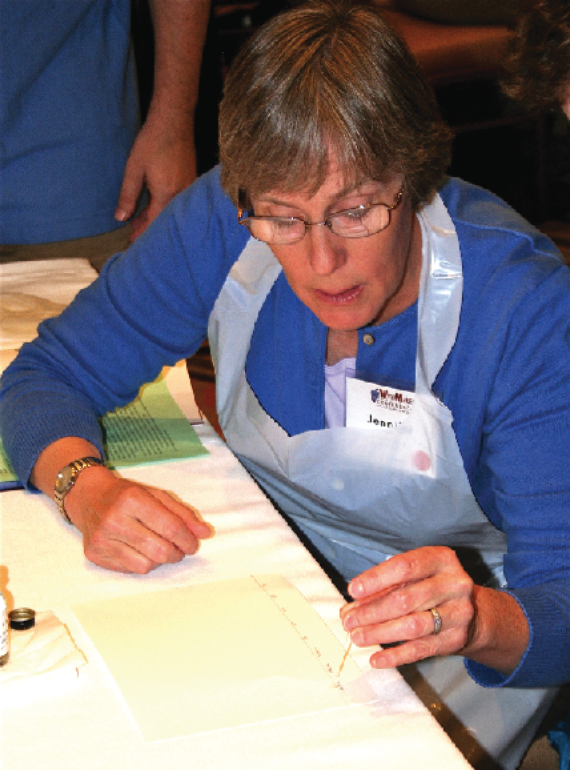
Home Winemakers, Let’s Take a Vote: Those of you who put your wines through malolactic fermentation only after the alcoholic fermentation is complete, raise your hands.
Now those of you who do both at the same time, in order to get it all over with, raise your hands.
Congratulations: Both teams are right — depending.
Commercial winemakers around the world are split on this one, with most in North America voting for the sequential track. (I’d guess a good three quarters of you voted for that way.) This question of timing has a tangled history, dating back to the
period not that long ago when nobody really understood the malolactic process at all. And a variety of circumstances and stylistic preferences can tilt the scales one way or another in a particular wine fermentation.
While there is not a clear, simple answer, there are some useful generalizations that can inform your winemaking. It can only help to know the factors involved before deciding to pitch now or pitch later.
A Brief History of Malolactic Timing
Before getting into the technical considerations, a quick historical survey of attitudes and hunches about this question can shed some light on the confusion. You’d think there would be a simple answer on something as seemingly straightforward as inoculation timing. But the entire topic has been clouded for decades by the two things that always befog thinking about winemaking: ignorance and alcohol.
Go back 50 years, maybe even 30 years, and hardly anybody had a clue about what made malolactic fermentation work, or even that what was going on had anything to do with malic or lactic acid. Winemakers knew that a while after the sugar had been converted to alcohol, maybe when the wines warmed up in the spring, fizzing and bubbling would start up again, and when it was over, the wine would be better, or at least different. Once the bacteria (or family of bacteria) that did the deed were identified, folks still weren’t all that sure about how to proceed. In France, the home of most of
the world’s fermentation microbe suppliers, winemakers were worried to death about bacterial spoilage, so the idea of intentionally adding more was less than appetizing.
Gradually, researchers and informed winemakers gained an understanding of how the malolactic fermentation worked, what it needed for success, and what bacteria executed it well (and badly). But nobody had handy packages of freeze-dried starter on sale; wineries had to take samples from one successful malolactic, build up a culture, and mix it into another tank — kind of like passing a sandwich around the table for everyone to bite into. The first modern direct addition starter, Chr. Hansen’s Vinaflora, only hit the US market in 1996.
Meantime, starting in the 1970s, Lisa Van de Water (later the founder of The Wine Lab and now Vinotec Napa) was leading some experimental research for the Robert Mondavi Winery, and her crew’s conclusion was that the best approach was to add a malolactic starter shortly after the alcoholic fermentation started. The warm environment helped the malolactic complete quickly, and the wine could be hit with sulfur early in its career, guarding against spoilage. This gradually became the conventional California wisdom.
Then alcohol got in the act. Van de Water points to the 1997 vintage in California: really big, really ripe, and the occasion for a veritable festival of stuck fermentations up and down the state. As I’ll explain in a minute, having an alcoholic fermentation stuck while a malolactic is underway is a very bad idea. So suddenly Van de Water began evangelizing for sequential fermentations: Make sure the primary is done before you mess with the secondary. Almost overnight, the conventional wisdom in California flipped 180 degrees.
Back across the pond, French winemakers had become fixated on stopping Brettanomyces, and the best way to do that is to get both the fermentations done quickly, using co-fermentation. So these days, the French industry practices co-fermentation, and the French suppliers think it’s (usually) the way to go. California is firmly in the sequential camp. And according to Duncan Hamm of Chr. Hansen, the Aussies split the difference, inoculating for malolactic late in the alcoholic fermentation at low Brix, often along with early pressing.
So whatever your practice, you can claim good company.
Yeast and Bacteria Needs
Now let’s examine this timing decision at the microbial level.
For a successful alcoholic fermentation, yeast need sugar to chew on, nutrients (nitrogen in the form of ammonia for energy, plus several minor nutrients), and for good extraction in red wines, warm temperatures.
Malolactic bugs, both the good ones (Oenococcus oeni) and the bad ones (the wide world of rogue lactic acid bacteria), need, first of all, some malic acid to work on, plus some amino acids and small stuff as nutrients. They have trouble with any pH less than 3.2, and prefer not to be around much SO2. And they like it warm, too, at least over 60 °F (16 °C).
Most of the time, for reds and barrel-fermented whites on a malolactic track, it should work just fine to co-ferment. The yeast and bacteria feed on their separate nutrients; both sets of microbes get started at low levels of ethanol and gradually get used to the rise; any initial SO2 at the crusher is quickly bound; and everybody stays warm and cozy.
The result is that the malolactic should complete shortly after the alcoholic fermentation, maybe at the same time. Which gets the wine to that happy point when a “killer” dose of sulfur can start protecting the wine from further microbial adventures. It makes the window between the end of the primary and the end of the secondary very narrow, which is a good thing: this interval is the very best opportunity for Brett to take hold and work its unpleasant magic.
Case closed? Not exactly.
Staying Out of Trouble
Even if co-fermentation seems like the default, there are a bunch of situations in which sequential might be a better or safer choice. To begin with, some juices and musts are going to have a hard time getting through malolactic, period: Lots with very low pH (under 3.2) and lots held at very low temperatures (under 60 °F/16 °C). In these cases, it’s probably better to concentrate on one fermentation at a time: A tank/carboy white, for example, might get fermented at 55 °F (13 °C), then warmed up to 65 °F (18 °C) to improve the environment for malolactic.
Among the issues specific to co-fermentation, the biggie is what might happen with a stuck alcoholic fermentation. If the primary ferment is in pause mode, and the malolactic chugs on to completion, the bacteria will move from eating malic acid (now depleted) to eating sugar as a backup strategy. And in wines with pH around 3.6 and up, this means a bumper crop of vinegary acetic acid as a by-product. As Van de Water puts it, you could have a, “sweet Cabernet Sauvignon with a completed malo.” Or as Jose Santos of Enartis puts it in technical terms, “You’re screwed.”
The implication is that if you are faced with an alcoholic fermentation that might be problematic — very high Brix, severe nutrient deficiencies, inadequate temperature control in case of heat spikes — you might want to hold off on the malolactic until the main job is done. Once again, it pays to know your numbers (and your fruit sources) and plan accordingly.
Yeast strain selection can also have implications for malolactic timing. Since Oenococcus bacteria are inhibited by sulfur dioxide, and yeast always produce some amount of SO2 during fermentation, yeast strains that don’t produce very much of the stuff are a better choice for co-fermentation. Lallemand has conducted scads of research into this issue of comparability, and the results came out in an article by Nicola Hall of Scott Labs in the Summer 2011 issue of Practical Winery and Vineyard. Yeast were graded into five categories of malo friendliness, ranging from “Most Compatible” to “Least Compatible.”
Strains commonly employed by home winemakers in the top two compatibility tiers included old friends QA 23, D254, 71B, Assmanshausen, RC212, GRE, D80, and Rhone 4600. In the bottom two tiers, strains producing above-average amounts of troublesome SO2 (and sometimes also unhelpful fatty acids), we find trendy yeasts like BM45, BA11 and MT. Smack in the middle category, sometimes happy to co-ferment, sometimes not, are the so-called Champagne yeasts — EC1118 and PDM — as well as RP15, T306 and Syrah. (The folks at Lallemand tested strains from other suppliers, but naturally did not publish those results.)
It’s not that the less-compatible strains are guaranteed to spoil the fun, just that they introduce a complication. Which makes this a good time to point out that the decision to co-ferment or go sequential usually does not depend on one single factor, but on weighing several considerations. For example, your co-fermentation with BM45 may go just fine, but if your must also has a super-high Brix and comes from a vineyard famous for nutrient deficiency, it might not be such a good idea.
The requirement that there be some malic acid around for the bacteria to chew on seems pretty obvious, but can be tricky. Low levels of malic acid — under half a gram per liter — can have two unfortunate consequences: either the bacteria will not find enough malic to sustain population growth, or they will polish off the malic in short order and move on to chomping sugar way too soon. This complexity is a good reason to find out the level of malic acid in your fruit — not just the total acidity. If the malic level is low, it might make sense just to leave it alone. Be forewarned that one grape variety commonly low in malic acid and thus tricky to put through malolactic is Merlot.
Co-fermentation works best, as noted earlier, at low levels of sulfur dioxide. Anything above a total of 40 parts per million and 10 parts free can be troublesome. So in addition to watching your yeast strains, keep sulfur additions at the crusher modest.
Of course, there is a question of timing the malolactic. The best practice seems to be adding a malolactic starter culture a day or two after the yeast addition, when the yeast have built up enough to start snapping, crackling and popping. This bit of lag time is why the practice is referred to as co-fermentation, not co-inoculation. A somewhat more conservative approach is waiting until near the end of the alcoholic fermentation, far enough along to know that the primary will not stick; this strategy still has the advantage of starting the malolactic in a warm environment.
Stylistic Choices
Besides the factors that influence the success of co-fermentation, there are some stylistic considerations, and some variety-specific complications. Merlot, as noted above, often arrives with very low levels of malic acid. In addition, the variety seems to develop certain polyphenols that inhibit malolactic activity and make completion difficult. There is some evidence that by the end of the alcoholic fermentation, the polyphenols get “coated” with other stuff that makes them less of a hindrance to successful malo.
You already suspected, of course, that Pinot Noir would be special, because, well, Pinot is always special. In this case, there are indications that the time between the completion of alcoholic fermentation and the completion of the malolactic is important for color stabilization — something Pinot producers worry about a lot — so having that period lengthened by sequential fermentation may be a good idea.
For white wine style, co-fermentation can result in stronger fruit expression and less of the buttery diacetyl character, since active yeast will suck up some of the diacetyl. If you want your Chardonnay buttery, go sequential; if you just want the mouthfeel rounded, without the butter thing, try a co-ferment.
For reds, Shea Comfort, who has conducted many of Lallemand’s yeast and malolactic trials, generally prefers sequential inoculation. For his taste, sequential fermentation produces a more structured, powerful wine; co-fermentation can round off and soften things too much, too soon. He acknowledges that this is an entirely subjective preference in wine style, and things like that are, after all, part of why winemaking is so much fun.
After talking with lots of researchers and sales reps and winemakers about this for some time now, my personal hunch — and that of the vast majority of people in the microbe business — is that the advantages of co-fermentation make it the default practice, unless there are specific issues with a particular fermentation. That’s not the dominant commercial practice in North America, and the bug vendors don’t go out of their way to pick fights with winemakers who are happy with sequential processing. Either way, they are going to sell you two products, whatever order you use them in.
But as a sign of the times, Lallemand has just introduced a new malolactic product called Beta Co-Inoc and is promoting it as particularly suited for co-fermentation. (Dear Lallemand: You keep calling it co-inoculation, though you tell people to wait 24 hours before adding the bacteria, which means it is not co-inoculation but rather co-fermentation.) The strain in question is good old Enoferm Beta, which has been around for several years in packaging that suggests sequential fermentation; but since it proved to be the most co-fermentation friendly in trials, it got a new name and packaging, and possibly a raise.
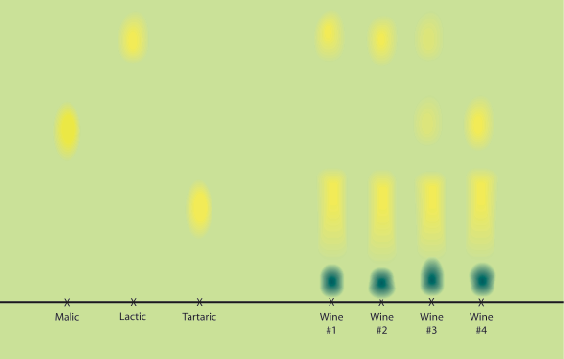
Testing for malolactic fermentation completion is done using a chromagram, which involves a solvent being carried up a piece of chromatography paper by capillary action. The acids in wine are carried up the paper for a particular distance — the more acid is attracted to the solvent, the higher it goes. In this example, the formic acid is allowed to dry and yellow acid spots appear, showing what acids are present in each wine sample.
